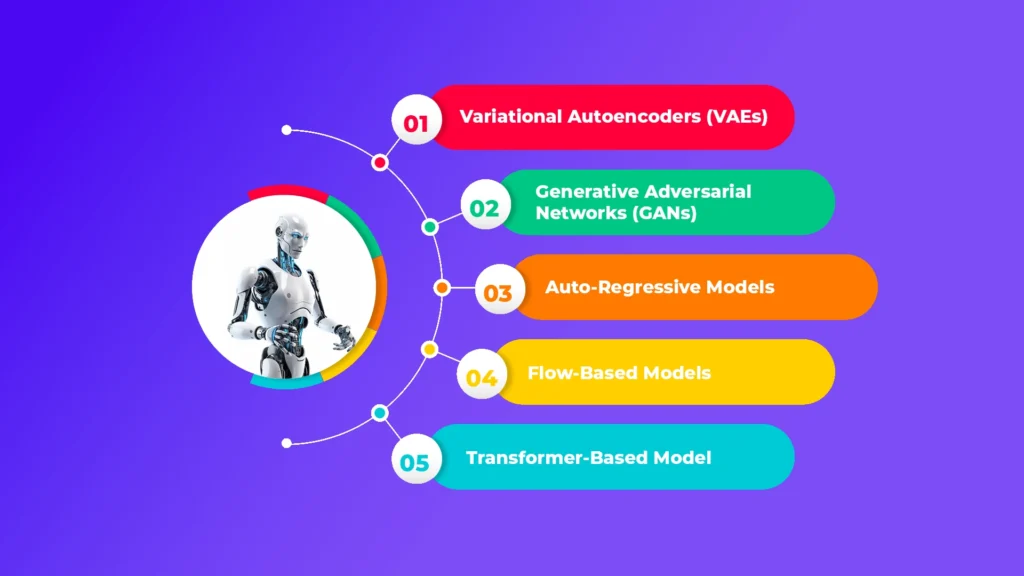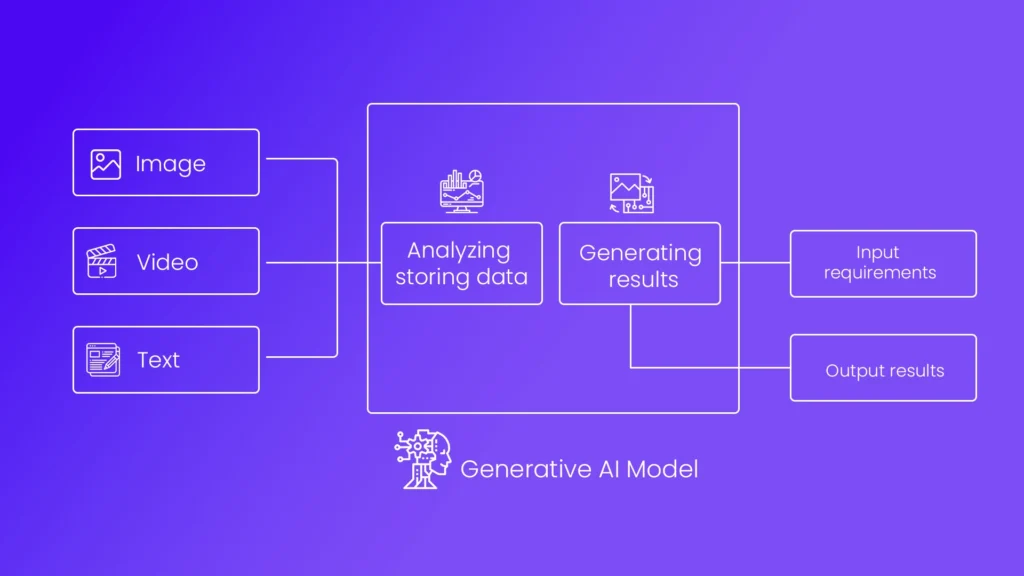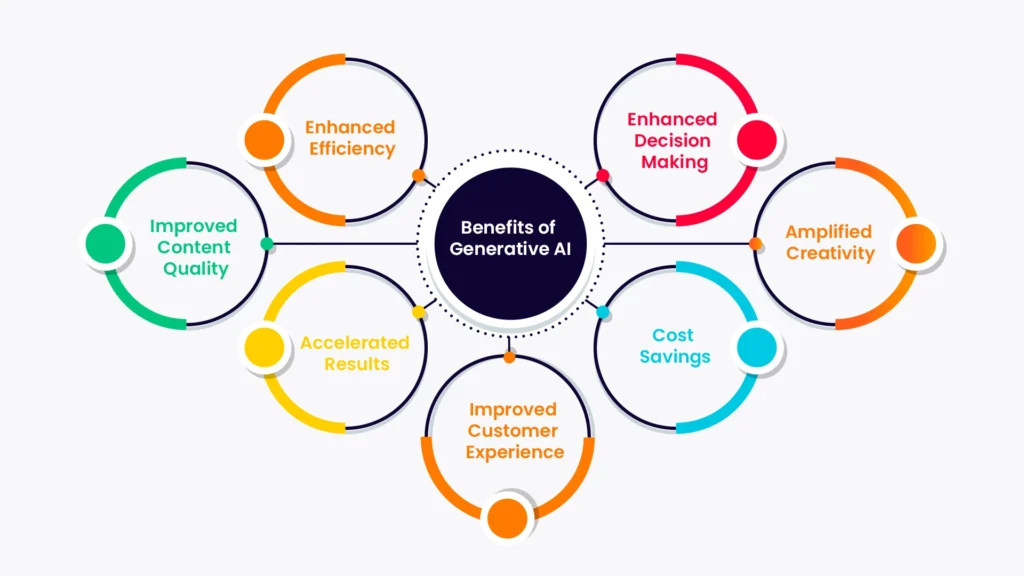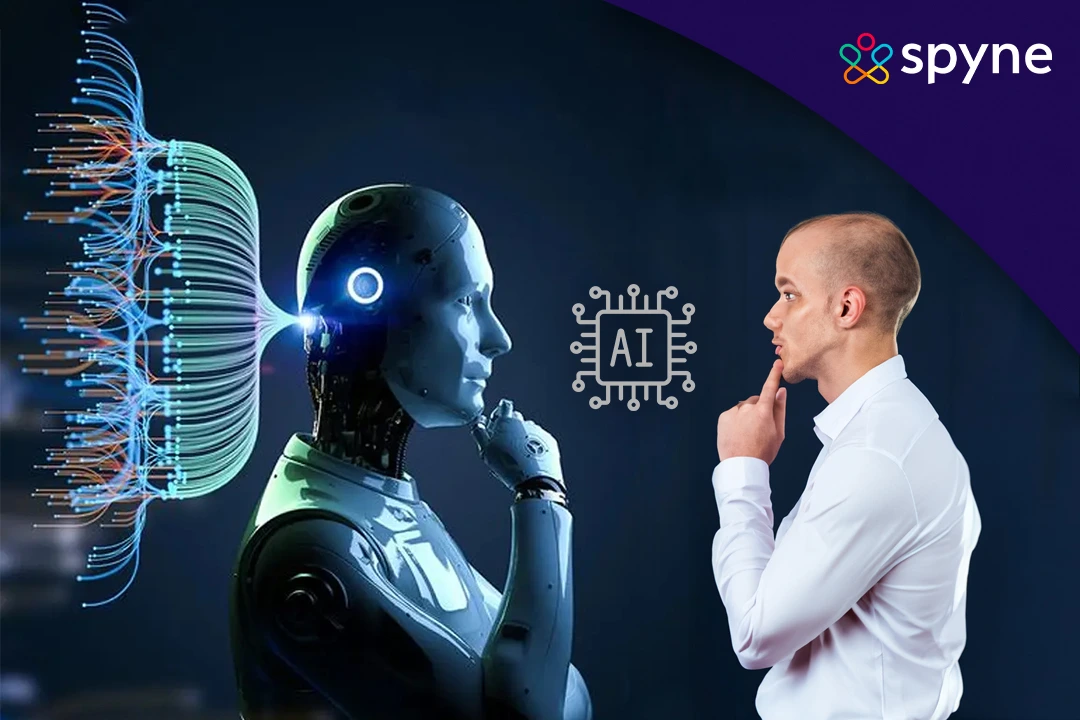Generative AI trends are here to stay. But you must be wondering what is generative AI.So why not take a closer look at the technology that is likely to transform all industries. In this insightful piece, we will delve into the transformative world of generative AI. This cutting-edge technology has the potential to revolutionize various industries and reshape the way we interact with artificial intelligence. We’ll cover everything from understanding its core concepts and underlying technologies to exploring its incredible applications and impact on society. Whether you’re a curious beginner or a seasoned tech enthusiast, join us on this enlightening journey to unlock the secrets and possibilities of thi technology. Let’s dive in!
What is Generative AI?
Generative AI systems represent a remarkable advancement in artificial intelligence technology, enabling the creation of diverse content, such as text, imagery, audio, and synthetic data. Recent excitement surrounds it stems from user-friendly interfaces allowing for the rapid generation of high-quality text, graphics, and videos in seconds. It’s worth noting that this technology has its roots in chatbots from the 1960s but truly flourished after the introduction of generative adversarial networks (GANs) in 2014.

Generative AI meaning may vary, but its function will always remain the same. GANs, a type of machine learning algorithm, empower the AI to produce convincing and realistic images, videos, and audio of real individuals. This newfound technology has brought about various advancements, including better dubbing of videos and high quality content for students. However, it has also raised concerns about deep fakes—digitally manipulated images or videos—and potential cybersecurity threats, such as devious requests mimicking an employee’s superior.
History of Generative AI
The origins can be traced back to the concept of machine learning, which emerged in the late 1950s. Scientists and researchers began exploring algorithms to generate new data, and one of the early examples of GenAI was the Markov Chain, a statistical model used to create new sequences of data based on input. Generative AI has been actively researched, During the 1960s Joseph Weizenbaum created a chatbot named ELIZA. It represented an early instance of Natural Language Processing (NLP) and aimed to emulate human-like conversations by generating responses derived from the text it was provided. However, due to limited computational power and data resources, these systems couldn’t flourish at that time. Only in the 1990s and 2000s, with the availability of advanced hardware and digital data, machine learning started to shine.
The birth of modern AI systems was marked by the development of neural networks, a type of machine learning inspired by the human brain. These models utilize interconnected layers of “neurons” to process and learn from data. Neural networks can recognize patterns in a dataset and make decisions or predictions without explicit programming for specific tasks.
The creative potential of this AI was unleashed with the introduction of Generative Adversarial Networks (GANs) in 2014, proposed by Ian Goodfellow and colleagues. GANs, a specific type of neural network, became a pivotal element in its progress.
Around the same time, other forms of generative models like Variational Autoencoders (VAEs) and Recurrent Neural Networks (RNNs) also gained prominence, showcasing their ability to generate novel content. These advancements propelled the field forward, leading to the development of more sophisticated models.
Generative AI vs. AI
The dissimilarities between these two branches of AI reside in their objectives, functionalities, and underlying technology. Traditional AI is designed to engage in human-like conversations and give expected results, while generative Artificial Intelligence is focused on generating fresh and newly distinctive content like text or images. As a result, their functionalities align with their respective purposes: conversational AI primarily aims to comprehend and respond to user inputs, whereas the other creates new content based on the inputs it receives based on the training from older data that existed.
Regarding technology, conversational AI utilizes NLP (Natural Language Processing), NLU (Natural Language Understanding), and NLG (Natural Language Generation) to grasp and interact with user inputs effectively. On the other hand, the generative version relies on machine learning techniques such as GANs (Generative Adversarial Networks) and transformer models to learn from extensive datasets and produce unique outputs.
Additionally, the user interface varies for these two AI types. Conversational AI typically adopts a chat-based interface, facilitating interactive conversations with users. In contrast, generative Artificial Intelligence lacks a standardized user interface since its outputs can encompass a broad spectrum, ranging from text to images, music, and more. But some of the generative AI has a big contribution in the field of background generator which has been revolutionary in the field of image editing.
Types of Generative AI Models
Top generative AI companies use different models to better this technology. These models can be classified into several types based on their architecture and the nature of the generated outputs.

Some common types of generative AI models include:
1. Variational autoencoders (VAEs)
Variational Autoencoders (VAEs) utilize an encoder-decoder architecture to transform input data into a latent space and subsequently reconstruct it back to its original data domain. They balance reconstruction accuracy and regularization to generate novel samples that adhere to the learned data distribution.
VAEs undergo a training process where the model’s parameters are optimized to minimize reconstruction error and regularize the distribution of the latent space. The latent space representation enables the generation of diverse and new samples by manipulating points within it.
VAEs find applications in various domains and generative AI companies, such as AI image generator, anomaly detection, and data compression. These models enable the generation of lifelike images, artistic synthesis, and interactive exploration of latent spaces.
2. Generative adversarial networks (GANs)
GANs consist of a generator network and a discriminator network that operate adversarially. The primary objective of the generator is to generate realistic samples, while the discriminator aims to differentiate between real and generated samples.
The training process involves an adversarial game, where the generator tries to deceive the discriminator, and the discriminator strives to correctly classify samples. Through this adversarial process, both networks enhance their performance iteratively.
GANs have made significant contributions to image synthesis, allowing for the creation of photorealistic images, style transfer, and image inpainting. Furthermore, they have found applications in tasks like text-to-image synthesis, using a text to image generator, video generation, and creating realistic simulations for virtual environments.
3. Auto-regressive models
Auto-regressive models create novel samples by modeling the conditional probability of each data point, taking into account the preceding context. They sequentially generate data, enabling the generation of complex sequences.
Auto-regressive models undergo training to predict the next data point based on the preceding context. In the inference phase, they generate fresh samples by sampling from the learned conditional distributions.
These models find widespread use in text generation, language modeling, and music composition. By capturing dependencies in sequences, they generate coherent and contextually relevant outputs.
4. Flow-based models
Flow-based models directly model the data distribution by establishing an invertible transformation between the input and output spaces. This approach enables both data generation and efficient density estimation. To achieve this, flow-based models leverage normalizing flows, a series of invertible transformations, to represent complex data distributions. These transformations facilitate efficient sampling and likelihood computation.
Flow-based models have diverse applications, including text to image generation, density estimation, and anomaly detection. They offer several advantages, such as in AI photoshoot, tractable likelihood evaluation, exact sampling, and flexible latent space modeling.
5. Transformer-based model
Transformer-based models have risen to prominence and achieved remarkable success in natural language processing (NLP) tasks.
A standout application of Transformer models is the language model called GPT (Generative Pre-trained Transformer). GPT-3 and similar models showcase their impressive ability to generate coherent and contextually relevant text when provided with a prompt. They have found utility in numerous NLP tasks, such as text completion, question answering, translation, summarization, and beyond.
How Does Generative AI Work?
Generative AI models utilize neural networks and machine learning algorithms to recognize patterns and structures to produce results based on training data sets while traditional AI uses patterns within training data set. Significant advancement in these models lies in their capacity to employ diverse learning approaches, such as unsupervised or semi-supervised learning during training. This capability empowers organizations to utilize vast amounts of unlabeled data more effectively and swiftly to create foundation models.

These foundation models serve as a base for AI systems capable of performing multiple tasks. Notable examples of foundation models include GPT-3 and Stable Diffusion, which excel in language-related applications. For instance, ChatGPT, drawing from GPT-3, enables users to generate essays based on brief text requests. Meanwhile, Stable Diffusion allows users to produce photorealistic images from text inputs.
Benefits of Generative AI
There are many Generative AI applications, and their benefits are uncountable. Generative Artificial Intelligence represents a form of AI designed to produce fresh content, including images, videos, and text.

It can help us in various ways, including developing greater invention and increasing overall productivity and efficiency while also helping make customization better. Generative AI art, which is extensively used by people, is one of the examples. So, here are some additional benefits that you must know
1. Enhanced efficiency
It automates tasks that would otherwise require manual effort, leading to time and cost savings while increasing overall efficiency. Rapid and accurate generation of images and videos, ideal for marketing campaigns and projects, becomes possible through this technology.
2. Improved content quality
It elevates content quality by creating visually appealing high-resolution images and videos, surpassing what can be achieved manually. Additionally, it generates precise and relevant text, surpassing human-created content.
3. Accelerated results
Businesses can achieve faster results using it compared to manual labor. It expedites image and video generation, completing projects swiftly and efficiently.
4. Cost savings
It helps businesses save money by automating tasks, reducing labor costs, and streamlining content creation expenses, such as those related to images and videos.
5. Enhanced decision making
It aids businesses in making informed decisions by generating valuable data. This data can be used for marketing campaigns, product development, and other strategic choices.
6. Amplified creativity
It fuels creativity by generating novel ideas and concepts, which can be harnessed for the creation of innovative products and services. Additionally, it produces visually captivating images and videos.
7. Improved customer experience
Through this technology, businesses can tailor content accurately and relevantly to meet their customers’ needs, leading to an improved customer experience and heightened customer satisfaction.
Limitations of Generative AI
Apart from the known limitations discussed below, it may be susceptible to issues that have not been fully recognized or comprehended.
1. Large language models (LLMs) may exhibit “hallucinations,” generating fictional information presented as factual or accurate. This can include citations, publications, biographical details, and other information commonly used in research and academic papers.
2. Moreover, answers generated by LLMs can be incorrect, yet they may be presented as correct or authoritative.
3. The fundamental structure of the AI models, coupled with the regular release of newer versions, can make it challenging to consistently reproduce content. This lack of reproducibility is particularly problematic in research and academia, where establishing credibility relies on replicability.
4. It is essential to note that the AI models are not databases of knowledge but rather an attempt to synthesize and reproduce the information they have been trained on. As a result, validating and accurately attributing the basis of their content becomes incredibly difficult.
5. Many common tools are not connected to the internet, making it impossible for them to update or verify the content they generate.
6. The nature of the models, especially when provided with simple prompts, may lead to overly reductive content, resulting in low-quality or generic outputs.
7. Numerous models, including ChatGPT, are trained on data with cutoff dates, leading to the inclusion of outdated information or the inability to provide answers about current events or information. In some cases, the data cutoff date is not explicitly communicated to the user
8. A biased dataset can be transferred, generating biased content.
9. The data that is provided is not mostly current, and tools may get sources that are out of date.
How Neural Networks are Transforming Generative AI
Neural networks have revolutionized generative artificial intelligence, enabling remarkable advancements in content creation, image generation, and language processing. Here’s how neural networks are transforming it:
1. Capturing complex patterns
Neural networks excel at recognizing intricate patterns within data, making them adept at generating realistic and high-quality content across various domains.
2. Image generation
Generative Adversarial Networks (GANs), a type of neural network, have made significant strides in generating photorealistic images, revolutionizing fields like art, design, and fashion.
3. Language processing
Neural language models, particularly Transformer-based architectures like GPT (Generative Pre-trained Transformer), have transformed natural language processing by generating coherent and contextually relevant text, leading to chatbots, language translation, and content generation advancements.
4. Improved training
Neural networks have made training the models more efficient and scalable, allowing researchers to train larger models on extensive datasets, leading to enhanced output quality.
5. Interactive content
Neural networks enable interactive content creation, as users can provide prompts or inputs to generative models and receive tailored outputs, fostering creative collaboration and personalized experiences.
6. Few-shot and zero-shot learning
Neural networks have enabled AI models to learn from limited or even zero training data, making them adaptable to new tasks and applications with minimal additional training.
7. Semantic understanding
Neural networks equipped with natural language understanding capabilities can produce content that goes beyond superficial patterns, resulting in more contextually relevant and meaningful outputs.
8. Style transfer
Neural networks can transfer the style of one image to another, allowing artists and designers to create unique and visually striking compositions.
9. Autonomous creativity
Neural networks can autonomously generate novel and creative content, encouraging exploration and experimentation in various artistic domains.
What are some Generative AI Example Tools?
There are many Generative AI tools that can be found on the internet. Each tool has its own feature and functions.
Here are some generative AI examples that are common and most popular.
1. Dall-E
Dall-E exemplifies multimodal AI, trained on a vast dataset of images and their associated text descriptions. This application connects various media, including vision, text, and audio, to identify correlations between words and visual elements. Utilizing OpenAI’s GPT implementation, Dall-E was introduced in 2021, followed by a more advanced version, Dall-E 2, in 2022. Dall-E 2 empowers users to generate imagery in multiple styles based on prompts.
2. ChatGPT
This AI-powered chatbot took the world by storm in November 2022, employing OpenAI’s GPT-3.5 implementation. Notably, OpenAI enabled interaction and fine-tuning of text responses through a chat interface with interactive feedback, an improvement over previous GPT versions accessible solely via an API. Subsequently, GPT-4 was released on March 14, 2023. ChatGPT stands out by incorporating the context of past conversations with users, creating a simulation of authentic dialogue. Its popularity prompted Microsoft to invest significantly in OpenAI and integrate a version of GPT into its Bing search engine.
3. Bard
Google also contributed to transformer AI techniques, notably for language and protein processing. However, Microsoft’s implementation of GPT into Bing motivated Google to rush to launch a public-facing chatbot, known as Google Bard. This chatbot utilized a lightweight version of Google’s LaMDA family of large language models. During its hasty debut, Bard faced criticism after wrongly stating that the Webb telescope discovered a planet in a foreign solar system, leading to a significant stock price drop for Google. Microsoft and ChatGPT implementations also faced challenges with inaccurate results and unpredictable behavior. Subsequently, Google introduced an improved version of Bard built on its most advanced LLM, PaLM 2, allowing Bard to be more efficient and visually engaging in responding to user queries.
4. GPT-4
GPT-4 represents the latest advancement in OpenAI’s Large Language Model series, succeeding GPT-3 and GPT-3.5. This model is promoted as being more imaginative, precise, and reliable while also incorporating enhanced safety features for a more stable user experience compared to its older counterparts.
5. AlphaCode
The transformer-based language model used in AlphaCode outshines several existing models, including OpenAI Codex, boasting an impressive 41.4 billion parameters. AlphaCode offers comprehensive programming language training, covering C#, Ruby, Scala, Java, JavaScript, PHP, Go, and Rust, with exceptional performance in Python and C++.
Some other AI tools include Scribe, Jasper, worldtune, GitHub Copilot, VEED, and Speechify.
What are the concerns surrounding generative AI?
To gain a comprehensive understanding of the responsibilities that accompany the use of this AI, we must address several key concerns:
1. Bias due to data bias
It has the potential to perpetuate bias present in its training data. For instance, if a system is trained on biased movie scripts, it may inadvertently produce content that reinforces stereotypes or promotes discriminatory narratives, perpetuating bias in the entertainment industry.
2. Spread of misinformation
The ability to create highly convincing fake content, such as text, images, and videos, raises concerns about the spread of misinformation and fake news. In the wrong hands, AI-generated realistic news articles could lead to confusion and manipulation of public opinion.
3. Job displacement/Loss due to automation
As technologies advance, there are worries about job loss and economic disruption, especially in creative industries. AI-generated music, art, and writing might replace human artists and content creators, leading to unemployment and livelihood challenges for many individuals.
4. Privacy issues owing to data leak
These systems often require extensive data for effective training, posing privacy risks. If chatbots powered by this technology collect and store personal information during conversations, there is a risk of mishandling or compromising this data, leading to privacy breaches and unauthorized access to sensitive information.
5. Who controls generative artificial intelligence?
As these systems become more sophisticated, there is a concern about who has control over the content they produce. AI systems capable of generating persuasive political speeches could be misused to manipulate public opinion or deceive individuals, raising ethical questions about responsible use and governance.
6. Overreliance on these applications
With the increasing capabilities, there is a risk of overreliance on these systems without proper understanding or critical evaluation. Relying heavily on AI-powered language translation tools, for example, might lead to accepting inaccurate or misleading translations, resulting in misunderstandings in crucial situations.
7. Unintended consequences
These systems learn from data patterns and correlations, which may lead to unexpected or unintended outcomes. For instance, an AI model trained to generate images of animals might produce bizarre and unrealistic hybrids that do not exist in the real world, leading to potentially confusing or nonsensical outputs.
8. Environmental impact (Increased Carbon Emissions)
Training and deploying these models at scale require significant computational resources, contributing to increased carbon emissions and environmental impact. Developing energy-efficient algorithms and adopting sustainable practices in the AI industry is vital to mitigate the environmental footprint.
9. Offensive and inaccuracy
Generative AI tools are designed to provide logical and valuable responses to user queries. However, it’s essential to acknowledge that, at times, these tools may produce offensive, inappropriate, or inaccurate content.
Best Practices for Using Generative AI
AI-generated content can potentially benefit businesses but also comes with legal, regulatory, and reputational risks. Below are ten high-level guidelines to help you understand the principles underlying the use of AI platforms in your business:
1. Understand copyright
Materials created solely by AI are not protected by copyright, but human additions to AI-created materials may be protected. Be aware of what elements were created by AI and what was added or changed by humans.
2. Review platform terms
Always check the terms and conditions of the AI platform you are using. Each platform may have different terms that permit or prohibit specific uses. Ensure the platform allows your intended use, and be prepared to obtain any necessary licenses.
3. Check agreements with third parties
If you are using this technology for clients or third parties, review your agreements with them. Some agreements may restrict AI use, and you may need to warrant your ability to assign a copyright.
4. Use AI in the creative process
It is useful for generating ideas at the start of the creative process. However, exercise caution when using mainstream platforms to create final content. Consider more bespoke applications following legal vetting.
5. Use original prompts and data
Avoid copying or adapting content from other sources when using it. Use original prompts and input data to ensure unique outputs.
6. Protect confidential information
Avoid using prompts that contain confidential or legally privileged information. Be mindful of contractual terms, especially if using secure AI sources that belong to a third party.
7. Avoid trademarks
Refrain from using brand names, logos, or trademarks in your prompts or input data to reduce the risk of infringing on third-party trademarks.
8. Be careful with specific information
Specific prompts might yield useful results, but using material that identifies third-party content, such as celebrity names or copyrighted designs, increases the risk of conflicting with others’ rights.
9. Maintain records
Depending on your use case, keep detailed records of your input data, AI-generated output, and any changes made to the material. This documentation can be useful in demonstrating the source of your work if needed.
The Future of Generative AI
Generative Artificial Intelligence is ushering in a new era of human efficiency and effectiveness, with far-reaching implications for both society and industry. In hindsight, this moment will be as revolutionary as the advent of personal computers and the introduction of the Apple iPhone.The future that we expect is that many designers may adopt AI, which will help them create increasingly complex objects and systems. Generative AI can also impact the way video games are made and played. It can also help in photo editing. It can bring changes across the entire organization, which includes its own IT walls. Organizations that set the stage for cloud adoption and on-premises automation might be well-prepared for seamless integration with generative AI capabilities.

These solutions empower business leaders to achieve previously unattainable levels of speed and scale in execution. Organizations can now automate and optimize business processes, extract novel insights, and deliver enhanced customer experiences at a remarkable pace. Implementing this technology for business transformation requires a thoughtful and intentional approach.
Tractable use cases involve automating repetitive tasks and synthesizing insights from unstructured data. This could mean streamlining high-volume tasks to save time or uncovering valuable information buried deep in documents and disparate data sources. The business impact should gauge success metrics and can tie to economic benefits, improved customer service, sustainability outcomes, or enhanced business efficiencies. As these changes take place within enterprises, scaling technologies and solutions will require a thorough evaluation of existing workflows. Leaders must assess how AI can transform the job functions of employees. Successful implementations will integrate these solutions seamlessly into existing customer and employee workflows, making them an integral part of the overall operational ecosystem rather than standalone tools.
Conclusion
As we conclude this journey through generative AI, we stand in awe of the immense potential and possibilities this technology holds. From its ability to create novel content to its impact on business, society, and beyond, it is undeniably shaping the future. As with any powerful tool, its responsible and ethical use becomes paramount. By understanding its capabilities, limitations, and the challenges it poses, we can harness its potential for the greater good. Embracing this technology with a mindful approach, we can pave the way for a future where this technology coexists harmoniously with humanity, unlocking a new era of innovation and creativity.





























